F6-05
DC brake current at start Factory default
value
0%
Setup range 0% ~ 100%
F6-06
DC brake time at start
Factory default
value
0.0s
Setup range 0.0s~ 36.0s
DC brake at start s generally used when the motor is restarted after it stops completely.
If the start mode is direct start, the inverter rstly performs DC brake in accordance with the DC
brake current at start, and then start running after the setup DC brake time at start. If the DC
brake time is set to 0, the inverter directly starts without passing through the DC brake.
The higher the DC brake current is, the higher the brake force is.
DC brake current at start refers to the percentage of rated current of the inverter.
F6-07
Speed-up/speed-down mode
Factory default
value
0
Setup range
0 Straight speed-up/speed-down
1 S-curve speed-up/speed-down
It is used to select the frequency change mode during the inverter start and stop process.
0: Straight speed-up/speed-down
The output frequency increases or decreases along the straight line. The speed-up/speed-
down time varies with the setup acceleration/ deceleration time. The MD320 series inverter
provides four types of speed-up/speed-down time. It can select speed-up/speed-down time via
the multifunctional digital input terminals (F4-00 to F4-08).
1: S-curve speed-up/speed-down
The output frequency increases or decreases along the S curve. S curve is generally used
in the applications where start and stop processes are relatively flat, such as elevator and
conveyor belt. Refer to F6-08 and F6-09 for the meanings of the parameters.
F6-08
Start segment proportion
of S curve
Factory default
value
30.0%
Setup range 0.0% ~ 40.0%
F6-09
End segment proportion
of S curve
Factory default
value
30.0%
Setup range 0.0%~ 40.0%
t1 in the following figure is the parameter set in F6-08, within which the output frequency
change slope increases gradually. t2 is the time dened in F6-03, with which the slope of the
output frequency change gradually decreases to 0. Within the time between t1 and t2, the slope
of the output frequency change remains xed.

